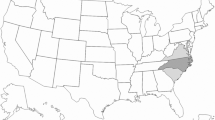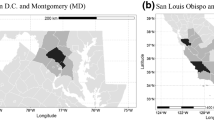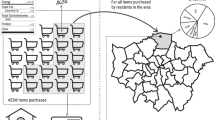Abstract
In theory, the nearest-nickel rounding scheme renders no financial gains for anyone given that each final digit has the same probability of appearing. However, in practice, rounding may yield non-zero net effects as most store prices end with nine. In this paper, price data from representative Canadian grocery stores are used to assess whether the current rounding system imposes a monetary loss on firms or consumers. Specifically, I evaluate how one- to ten-item purchases and the six different Canadian provincial sales tax rates influence penny-rounding. The results show that penny-rounding financially benefits the firms at the expense of the consumers, imposing a net transfer of approximately $3.27 million CAD from consumers to grocery vendors every year. This amount averages to $157 of additional revenue for a typical grocery store per year.

Similar content being viewed by others
Notes
In this paper, grocery store serves as an umbrella term for general grocery stores, supermarkets, and convenience stores. This is because the types of items used in this study can generally be found at any of the venues above. However, I exclude warehouse clubs, wholesale distributors, and discount stores from this generalization.
In this paper, a fair rounding scheme describes a scenario in which all final digits are equally likely, such that the expected net rounding is zero.
The population of Canada is used as a proxy for the number of consumers in the country. Data are obtained from 2011 Census Population by Year by Statistics Canada (2013b).
The number of grocery stores in Canada, including supermarkets and convenience stores (Retail Council of Canada 2013).
References
Allison, Carman (2014, January 14). For Grocery, Opportunity in Those Falling Trips. Retrieved from http://www.canadiangrocer.com/top-stories/for-grocery-opportunity-in-those-falling-trips-36543. Accessed on June 7, 2017.
Canada Revenue Agency (2007). Basic Groceries: GST/HST memorandum 4.3. Retrieved from http://www.cra-arc.gc.ca/E/pub/gm/4-3/4-3-e.html. Accessed on June 7, 2017.
Chande, D., & Fisher, T. C. G. (2003). Have a Penny? Need a Penny? Eliminating the One-cent Coin from Circulation. Canadian Public Policy, 29(4), 511–517.
Government of Canada (2012). Economic Action Plan 2012. Retrieved June 7, 2017 from https://www.budget.gc.ca/2012/plan/pdf/Plan2012-eng.pdf. Accessed on June 7, 2017.
Henry, C., Huynh, K. P., & Shen, R. (2015). 2013 Methods-of-Payment Survey results. Bank of Canada Discussion Paper, 2015(4).
Lombra, R. (2001). Eliminating the Penny from the U.S. Coinage System: An Economic Analysis. Eastern Economic Journal, 27(4), 433–442.
Retail Council of Canada (2013). The Structure of Retail in Canada Statistic. Retrieved June 7, 2017 from http://www.retailcouncil.org/sites/default/files/documents/the-structure-of-retail-in-canada-statistical-appendix-2013.pdf. Accessed on June 7, 2017.
Royal Canadian Mint (2013). Phasing out the Penny. Retrieved June 7, 2017 from http://www.mint.ca/store/mint/about-the-mint/phasing-out-the-penny-6900002#.WULniHcZNpV. Accessed on June 7, 2017.
Statistics Canada (2013a). 2011 Census Population by Year. (CANSIM table 051–0001). Retrieved March 3, 2017 from Statistics Canada at http://www.statcan.gc.ca/tables-tableaux/sum-som/l01/cst01/demo02a-eng.htm. Accessed on June 7, 2017.
Statistics Canada (2013b). 2011 Census Private Households by Structural Type of Dwelling. (Catalogue number 98–313-XCB). Retrieved March 7, 2017 from Statistics Canada at http://www.statcan.gc.ca/tables-tableaux/sum-som/l01/cst01/famil55c-eng.htm. Accessed on June 7, 2017.
Acknowledgements
I would like to express my deep gratitude to Professor Michael Vaney and Professor Jonathan Graves for their patient guidance, enthusiastic encouragement and critiques of this research.
Author information
Authors and Affiliations
Corresponding author
Additional information
Christina Cheung was the first place winner of the Best Undergraduate Paper Award Competition at the 84th International Atlantic Economic Conference in Montreal, Canada, October 5-8, 2017.
Rights and permissions
About this article
Cite this article
Cheung, C. Eliminating the Penny in Canada: An Economic Analysis of Penny-Rounding on Grocery Items. Atl Econ J 46, 231–239 (2018). https://doi.org/10.1007/s11293-018-9584-8
Published:
Issue Date:
DOI: https://doi.org/10.1007/s11293-018-9584-8




